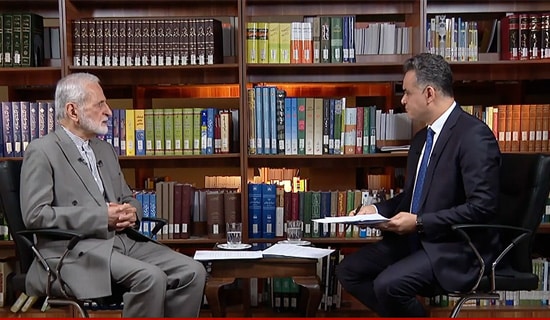Against the backdrop of the U.S. administration's announcements that it intends to level oil and banking sanctions against the Iranian regime, regime officials once again responded with vehement statements expressing their intention to prevent any country from shipping oil via the Persian Gulf (see for example statements by Iranian President Hassan Rohani on July 3, 2018). Many inside and outside Iran have interpreted these statements as an Iranian threat to close the Strait of Hormuz.
Even before European sanctions were imposed in 2012, and also in order to pressure the U.S. and Europe during the years of nuclear negotiations with them, senior Iranian regime officials threatened more than once to close the Strait of Hormuz. However, it should be stressed that despite all the threats, and the sanctions against Iran, the Iranian regime never dared to carry out its threats.
It should be noted also that in the past Iranian officials had occasionally threatened to close the Strait of Hormuz as deterrence against the Gulf countries and the West. See MEMRI Inquiry and Analysis No. 615, Iran Demonstrates Its Deterrent Strength in Military Maneuvers, June 14, 2010; Special Dispatch No. 2029, Iran Threatens to Close Strait of Hormuz If Attacked, August 19, 2008; and Inquiry and Analysis No. 407, Iran's Response to Western Warnings: "First Strike, "Preemptive Attack," "Long-Range Ballistic Missiles," "Asymmetric [Guerilla] Warfare," December 2, 2007).
Below are two MEMRI Special Dispatches on threats by the Iranian regime to harm oil shipping in the Gulf, published in December 2011 and in February 2012, before the European oil and banking boycott against Iran came into force: "Article On Iranian Website: This Is How We'll Close Strait of Hormuz", and "Iranian Websites Publish Threats against U.S. Targets in Gulf."
MEMRI Special Dispatch No. 4391: Article On Iranian Website: This Is How We'll Close Strait of Hormuz – December 28, 2011
In response to threats by Western countries to impose oil sanctions on Iran, the Iranian website Mashreq News, which is close to Iranian military circles, posted an article on December 15, 2011 outlining military measures that could be taken by Tehran to close the Strait of Hormuz should the regime choose to do so.
The article enumerated the forces and weapons that Iran could employ in such a military operation, including fast attack craft carrying anti-ship missiles; submarines; battleships; cruise and ballistic missiles; bombers carrying laser-, radar- and optically-guided missiles; helicopters; armed drones; hovercraft and artillery.
It stated that despite Iranian Supreme Leader Ali Khamenei's statements that Tehran would not initiate a military confrontation but would retaliate harshly if attacked, "there is no guarantee that [Tehran] will not launch a preemptory strike on the civilian level, for instance through cyber-warfare or by means of economic pressure, including by closing the Strait of Hormuz and cutting off [this] energy lifeline for an indefinite period of time." It added, "Should additional sanctions be imposed on Iran, especially in the domain of oil export, Iran might keep [its] oil from leaving its territorial waters."
In a further threat, the article stated that Iran would in the future be able to attack the 480-km pipeline with a capacity of 2.5 million barrels/day[1] that the UAE is planning to build in order to bypass the Strait of Hormuz in order to neutralize Iran's ability to disrupt the world's oil supply: "As for the plan... to construct a [pipeline] from the UAE that will be an alternative in times of emergency in case the Hormuz Strait is closed, we should note... that the entire territory of the UAE is within range of Iran's missiles, [so Iran] will easily be able to undermine security at the opening of this [pipeline] using weapons to be discussed this report."
In accordance with Iranian doctrine, the article pointed out that these weapons would actually not be necessary because there would be suicide operations, and added that "the faith of the Iranian youth, and their eagerness to sacrifice their lives, will sap the enemies' courage."
Despite statements by Iranian government spokesmen, including Oil Minister Rostam Qasemi and Foreign Ministry spokesman Ramin Mehmanparast, that the closing of the strait is not currently on Iran's agenda,[2] Majlis National Security Committee member Pervez Sarouri said that the Iran would be conducting 10 days of naval maneuvers, called "Velayat 90," beginning December 24, 2011, to drill closing it.[3]

Satellite view of the Strait of Hormuz connecting the Persian Gulf to the Sea of Oman
Kayhan editor Hossein Shariatmadari, who is close to Khamenei, called on the regime to announce immediately that Tehran would close the strait to vessels from the U.S., Europe, Japan, or any other country participating in imposing oil sanctions on Iran.[4]
At a press conference on the subject of the Velayat 90 naval maneuvers, which commenced on December 24, Iranian Navy Commander Habibollah Sayyari said that his forces would be capable of closing the strait if asked to do so.[5]
It should be noted that Iranian officials have previously threatened to close the strait as a means of deterring Iran's neighbors and the West (see previous MEMRI reports from 2010, 2008 and 2007).[6]
The following are the main points of the Mashreq News article on closing the Strait of Hormuz.[7]
Fast Attack Craft
The article stated that since it first introduced fast attack craft for use in the Iran-Iraq war (1980-1988), the Iranian navy has immeasurably improved the craft's "ability to face advanced enemy combat vessels, much less cargo ships. These boats are equipped with sea radar systems; advanced electronic communication systems; sea-to-sea cruise missiles, both short-range – 25 km – and medium range; medium- and large-caliber [sic] torpedoes; and naval mines, along with traditional means of warfare – including semi-heavy machine guns, missile launchers, and shoulder-launched anti-aircraft missiles. These sea craft are capable of blocking the Strait [of Hormuz] for a brief or an extended period, and of facing enemy warships trying to open the route.
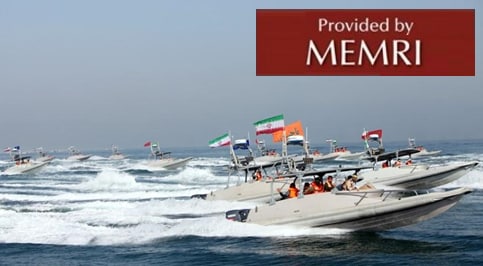
"In addition to their high speed and abovementioned equipment, these sea craft are highly maneuverable. Their ability to operate at night, aided by the requisite accessories, as well as in stormy weather, has been demonstrated repeatedly in recent years, in maneuvers both minor and major. Their successful record includes stopping submarines from countries beyond the [Gulf] region that aimed to cross the Strait of Hormuz, and supporting [Iranian] submarines threatened by enemy warships in the Indian Ocean... Iran has various types of naval mines, both stationary and remote controlled. This weapon [i.e. the mines] may, if necessary, be operated by Iranian boats and submarines [located at] various points in the Strait of Hormuz and the surrounding waters."
Submarines
The article continued: "The Iranian navy's acquisition of submarines... some 20 in number... has rendered it more powerful than the navies of the [other] countries in the region. Iran's submarine craft can use torpedoes, mines, and missiles, and can remain submerged for weeks in order to accomplish a mission. Apart from the Russian Kilo class submarines, the Nahang, Ghadir, and Fateh class submarines have been pre-fitted for the waters around Iran, especially the Persian Gulf... These submarines can remain stationary in the water and can evade various enemy radar and sonar systems...
"The Kilo class submarines can carry 24 mines or 18 large torpedoes, while the Fateh class submarines can carry 12 torpedoes and/or eight mines. In addition, there have been reports in the international media stating that Iran has equipped the Kilo class [submarines in its fleet] with Hoot torpedoes...
"The Ghadir class submarines can also successfully participate in the operation [to close the strait]... [These] are small submarines manned by one or several people. Known as 'wet submarines,' they are used for commando operations, laying mines, and firing torpedoes... and can operate in narrow and shallow areas."
Warships
The article stated that "Iran has various classes of missile ships, warships, and destroyers. These marine craft are capable of launching four 'Nour' anti-ship missiles, which have a range of 120-170 km, [even] over 200 km. Additionally, these warships' 114mm and 76mm guns... can threaten various [types of] ships. [Iran's] warships can [also] threaten submarines while simultaneously operating together with the rest of the [Iranian naval] force in closing the Strait of Hormuz."
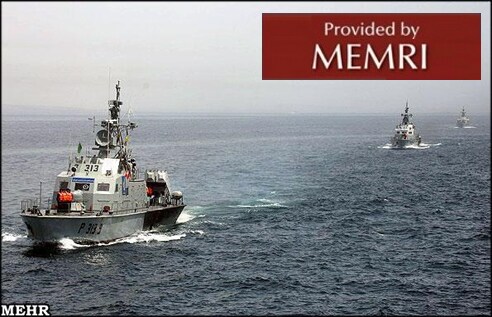
Anti-Ship Cruise Missiles
It continued: "We divide Iran's missile force into two groups: cruise missiles and ballistic missiles. They possess a wide variety of ranges and destructive capabilities. Coastal launchers for Kowsar short-range missiles and for Nour and Ghadir missiles [with a range of some 200 km] have so far been displayed, and the Naser-1 medium-range missiles are launched from Qare'a triple-barrel missile launchers. These launchers are independent, meaning that if they are deployed near the coast, they could detect and identify naval targets and attack them without the need for supporting systems from [Iranian] air and naval units.

Independent cruise missile launcher
"These systems can cover most of the Strait of Hormuz if deployed and camouflaged 70 to 150 km deep into Iranian territory, or even in the Kerman province [in southeastern Iran]. The Iranian armed forces possess these systems in abundance, and they are ready for deployment."
Ballistic Missiles
The article noted: "...Thus far, three types of anti-ship ballistic missiles have been displayed in Iran: Khaleej-e Fars, Tondar, and Sejil. Khaleej-e Fars missiles, with a 300-km range and a 650-kg warhead, are designed to destroy enemy warships. The missile can be prepared for launch in a few minutes due to its use of solid fuel and advanced guidance systems. It strikes the enemy ships from above, traveling at Mach 3, reaching [the target] in a short time and at an acute angle.

Triple-barrel launcher for Khaleej-e Fars missiles; Tondar missile
"The triple-barrel launcher for these missiles provides sufficient firepower from the first launch; it increases the operational effect of the missile, while decreasing the enemy's ability to retaliate. Based on photos of the missile, it uses an electronic guidance system, which ensures its effectiveness even against the enemy's electronic warfare. The missile's speed, angle of approach, and impact from above are effective points in its modus operandi. We can estimate that the enemy's chances of intercepting it are miniscule.
"The Tondar missile, whose range is estimated by experts to be 150-250 kilometers, operates alongside the Khaleej-e Fars missiles as a short range ballistic missile... and their combined operation can significantly raise the chances of hitting the target... The [Tondar] missile can cover the Straits of Hormuz from deep inside Iranian territory. The Khaleej-e Fars missile can cover the Western Sistan-Baluchestan area, the Kerman province area, eastern and southern Fars province, and all of the Straits of Hormuz."
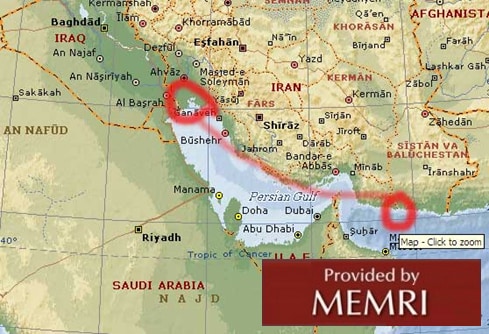
Image source: Sobh-e Sadeq (Iran), August 11, 2008; Fars (Iran), August 9, 2008
"The most terrifying of all Iranian missiles is the Sejil long range missile. It has commonly been considered merely a surface-to-surface missile, but the armed forces recently announced that it can also be used to destroy naval targets. Although not much is known about the missile's guidance and targeting systems, the missile has shown great accuracy in hitting a predetermined target. This missile, with a range of 2,000 km, can reach speeds of Mach 8 to Mach 12 (2,700-4,100 meters per second)... Its warhead weighs at least 500 kilograms, helping it to destroy the target. This missile can be used to cover regions beyond the Strait of Hormuz even if deployed on the northern Iranian coast, or at the most distant point in northwest Iran. It is a two-stage rocket powered by solid fuel, and reaches great speed at the end of the first stage [of launch]. It is difficult for the enemy to detect and track it during the first stage, because it uses several methods to reduce its radar signature... Thanks to its high velocity, the chance of it being hit by enemy defense [systems] is even smaller than the chance that they will hit a Khaleej-e Fars missile.
"Such missiles would be launched from deep inside Iranian territory because scattering launchers over a larger area will make it difficult for the enemy to detect them, will limit the means the enemy will be able to use to destroy them, and will also allow the launchers to be relocated and re-camouflaged.
"Although the enemy is much more likely to detect lower-velocity missiles... the combination of the use of these weapons in areas both closer and farther away from the shore and the increased number of targets... can maintain their effectiveness."
Bomber Jets
The article stated: "Iranian fighter jets can carry various types of air-to-surface missiles that can operate against naval targets, including air-to-surface missiles with optical, laser, and radar guidance; Nour and Ghadir missiles adapted for aerial use; C-801K and C-802 missiles; as well as Kowsar and Naser missiles. [Iranian] Air Force jets can carry up to five such missiles.

SUPPORT OUR WORK

"Additional missiles for naval targets include: limited range TV-guided Maverick missiles; Qassad-1 and Qassad-2 optically guided bombs with a range of 30-50 kilometers (Qassad-3 bombs, with a range over 100 kilometers, will become operational soon); and Russian-made KH-25 and KH-29 missiles with laser and optical guidance, which can be mounted on Su-24, Su-25, and MiG-29 jets. Their range is 10km-30km, and they have medium destructive capabilities.
"In addition, KH-58 long-range anti-radar missiles, which can be mounted on Su-24 jets for attacks on enemy warships, will play an important role in closing the Strait of Hormuz.
"The array of missiles and bombs with varying ranges will assist Iran in operating remotely against enemy frigates and warships."
Helicopters
"The Shahed 285 helicopter can carry Kowsar anti-ship cruise missiles, and Mi-171 helicopters can launch Nour long range missiles, and apparently Ghadir missiles as well. These helicopters, along with Cobra attack helicopters, can threaten merchant vessels and enemy warships."
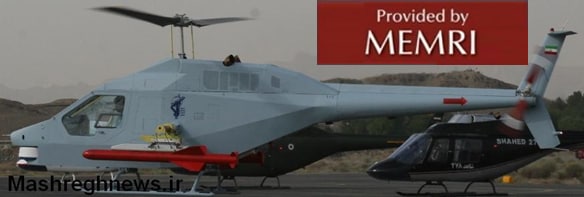
Shahed 285 helicopter equipped with anti-ship missile
Flying Boats
"Only one model of flying boat has thus far become operational in Iran. In fact, it is a new type of plane that can land on the water, and can be equipped with anti-ship missiles. This boat can take off from the water, from various points on Iran's coast, and can operate against enemy warships together with aerial defense."
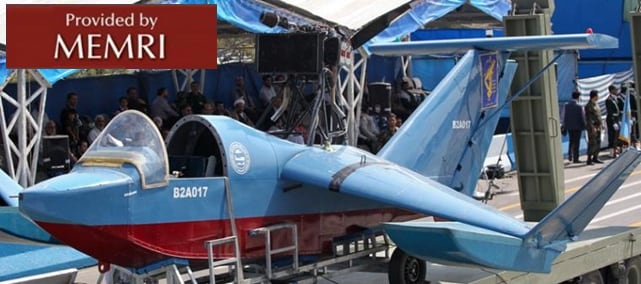
Drones
"The Iranian army drones are used for anti-ship missions. The Karar drone can carry four Kowsar missiles. Due to its speed, the drone can increase the potential energy of the missiles and extend their range. The drone has a range of some 1,000 km; it is launched by a rocket, and when it reaches the correct range, it launches the missiles. Karar drones can carry dozens of missiles to the enemy warships.
"The Karar drone is made from materials that allow it to evade radar detection and get close to enemy vessels. Nevertheless, the drone can also use missiles like Naser-1, for large areas."
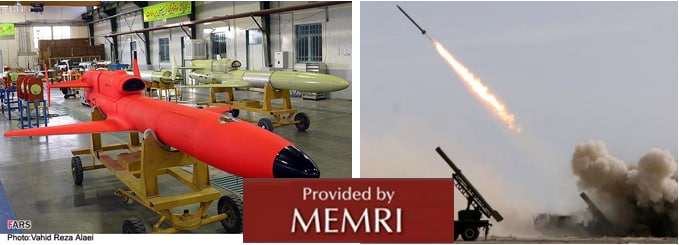
Karar drone
Artillery and Surface-to-Sea Rocket Systems
The article also claimed that Iranian security officials several times pointed out that guided bombs are actually being used against moving naval targets. It said that the range of Iranian artillery shells is over 40 km, and that they can be used to harm or destroy enemy ships. It added that during maneuvers, Iran had successfully utilized the Fajr-3 and Fajr-5 rocket launchers against naval targets.
MEMRI Special Dispatch No. 4467: Iranian Websites Publish Threats against U.S. Targets in Gulf – February 1, 2012
Tehran has responded angrily to Europe's boycott of Iranian oil, and to the boycott of Iran's Central Bank, announcing a counter-boycott and making threats against the West. The threats included a closure of the Strait of Hormuz, strikes against UAE and Saudi oil transport traffic, and military strikes against American sites in the Gulf.
Additionally, in December 2011, three weeks before the European boycott was announced, Iranian websites reported on willingness in Iran to carry out suicide missions against U.S. targets in the region and gave details of a plan for launching Iranian missiles at U.S. bases in the region.
The following is a summary of the threats:
Senior Iranian Officials: Close Straits, Attack U.S. and Gulf Targets
Following the January 23, 2012 announcement that Europe would boycott Iranian oil, Iranian Majlis National Security Committee deputy chairman Hossein Ebrahimi said that Iran would close the Strait of Hormuz and would not allow other countries to export oil via the strait if it was not allowed to export its oil. He added, "The Persian Gulf will become a graveyard for all the forces that will come from all corners of the earth to this sensitive region."[8] Another committee member, Isma'il Kowsari, said, "If there is any disruption of Iran's oil sales, we will doubtless close the Strait of Hormuz." He added, "If the U.S. tries to prevent the closure of the strait, Iran will within a short time strike at American targets across the world, and it will not allow U.S. forces to escape from the region."[9]
During Friday prayers on January 27, 2012, in Mashhad, northeastern Iran, preacher Ahmad 'Alam Al-Hoda, a member of the Assembly of Experts, said: "Do not doubt that Iran has the capability to blockade the UAE and Saudi tankers departing for Europe via the Strait of Hormuz."[10]
Prior to the announcement of the European boycott, senior Iranian officials had threatened to strike at U.S. sites in the Gulf states. At a November 15, 2011 Basij convention, Basij commander Mohammad Reza-Naqdi said, "The U.S. Fifth Fleet in Bahrain, the American land forces [base] in Kuwait, and the U.S. Air Force [base] in Qatar are entirely surrounded by holy fighters of the Islamic ummah who are counting the minutes in anticipation of the command to wipe out the U.S." He added, "The U.S. is so wretched that if Iran launches a military attack [against it] it will not respond militarily and will beg for negotiations." [11]
Another army official, Iranian Army Self-Sufficiency Jihad commander Rear Adm. Farhad Amiri, stressed that the American aircraft carriers were easy pickings for Iranian submarines. He explained that because of how the submarines were equipped, they could lie in wait for the Americans undetected and could strike at them from the bottom of the sea.[12]
Article on Iranian Website: "We Welcome War"
On the eve of the Iranian Navy's extensive Gulf maneuvers in December 2011, the conservative Serat News website, which is close to Hossein Shariatmadari, editor of the Kayhan newspaper, published an article by blogger Ali-Reza Forghani titled "We Welcome War." The article glorifies jihad and martyrdom against the U.S. and warns it and its leaders that not only do the Iranians have no fear of war, but they long to die in it. The article also set out details of threats, including suicide missions against American targets. The following are highlights of the article:
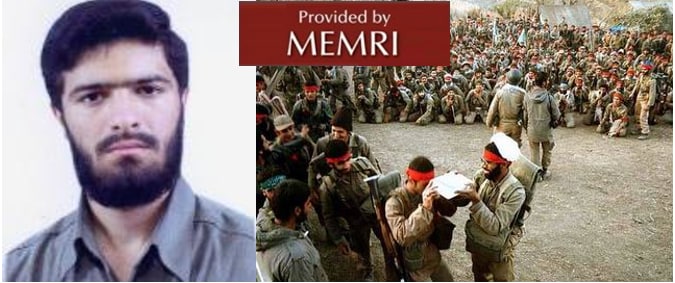
Ali-Reza Forghani (Source: Alireza-forghani.blogfa.com);Photo accompanying article: Fighters kiss the Koran before setting out for battle
"America needs to know that if it attacks Iran – the Muslims must [attack] it in response, based on the instructions of the religion, and they will not hesitate for a moment to carry out this religious duty. America needs to know that while [the American administration] was preparing the American people for the wars of 2001 [apparently a reference to the war declared by President Bush on Afghanistan after 9/11], 2012 and 2035... which will demand a high price, the Shi'ite youths were anticipating the appearance [of the Hidden Imam] and, as a result, they are ready for war and jihad.
"America needs to know that, while it tempts its young people with monthly salaries of $9,000 to fight in other countries, we have learned that if we do not carry out jihad or aspire to do so, then we die in a kind of hypocrisy, [and] death of this kind is shameful for us, [for] the aspiration to wage jihad [and to die] in war is our pride.
"America needs to know that the children of [founder of the Iranian Revolution Ayatollah] Ruhollah [Khomeini] and the companions of Ali [Iranian Supreme Leader Ali Khamenei] are not like the young people of the neighboring countries. Although they [too] are Muslims, they have never internalized the [words of the] Imam Ali, [father of the Shi'a], who said 'No people was attacked in its home unless [it first became] wretched.' We have learned that there is no need to drag war [into our] home and that we must locate the playing field [i.e. battlefield] anywhere outside our home, as quickly and safely [as possible].
"America needs to know that there are young people of Hizbullah who have located [the battlefield] outside Iran, and that they will carry out attacks and martyrdom operations within less than 48 hours [if America attacks,] in every one of the 112 countries in which America has a military base.
"America needs to know that while the American youth shouts the slogan 'Stop the war,' for fear of dying, the children of Ruhollah never flee from war and always pray 'Allah, give us martyrdom for Your sake.'"[13]
Iranian Website: This Is How We'll Strike At the American Bases in the Region
On December 14, 2011, the Mashregh News web site, which is close to Iran's security circles, published an article examining Tehran's ability to strike at U.S. bases in the region. The article included statistics about the bases and their respective distances from Iran's borders, and about the missiles that Tehran would use against them. The list included U.S. bases in Saudi Arabia, Turkey, Qatar, Kuwait, Afghanistan, Bahrain, the UAE, Oman, Kyrgyzstan, and Pakistan.
The article stated also that the U.S. air defense systems across the region were inefficient and that they would be quickly targeted by Iran's missiles. The following are the highlights of the article and the images that accompanied it:[14]
"This report will examine the distances of the important U.S. bases [from Iran's borders], particularly its Air Force bases along Iran's borders, along with Iran's missile capability to threaten these sites.
"The U.S. has bases, or uses bases, in the following countries: Turkey, Iraq, Kuwait, Saudi Arabia, Bahrain, Qatar, UAE, Oman, Afghanistan, Pakistan, and Kyrgyzstan...
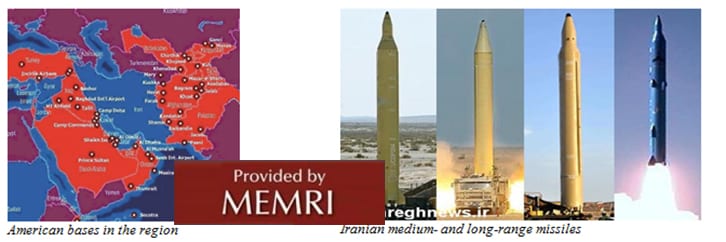
"These are the rockets manufactured by Iranian experts: the Naza'at H10 with a maximal range of 130 km, the Zilzal 3 with a range of 200 km, and the Zilzal B3 with a range of 250 km, suitable for striking the bases of the enemy in the region.
"These are the missiles that can threaten the more distant enemy bases: Fath 110, Qiam, Shihab 2, Shihab 3, Qadr, 'Ashoura, Sejjal 1, Sejjal 2...
"Kuwait, a small country which is [less like a country and] more like a large American military base, has two air force bases and six military camps. The Ali Al-Salam air force base, which is 115 km from Iran's borders, can be easily threatened by any of the above [Iranian] rockets and missiles... The runways at this air force base are about 3,000 meters long, suitable for most light and heavy aircraft.
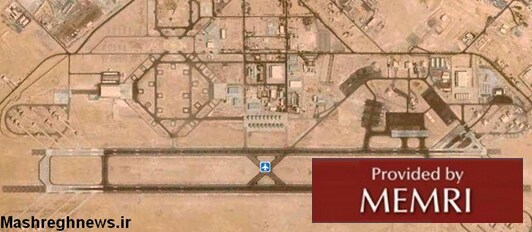
Ali Al-Salam AFB
"Another airfield in Kuwait open to the Americans is the Ahmad Al-Jabr air force base, located 134 km from Iran, and within range of [Iran's] Zilzal rockets and various Iranian ballistic missiles...
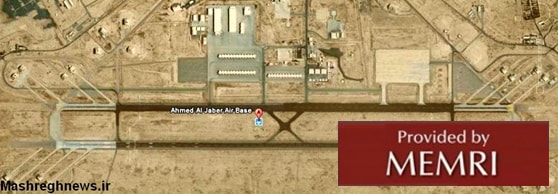
Ahmad Al-Jabr AFB
"The camps at which U.S. military forces are stationed are Camp Doha, located 94 km from Iran; Camp Buehring, located 104 km from Iran; Camp Spearhead, located 109 km from Iran; Camp Patriot, located 123 km from Iran; and Camp Arifjan, located 126 km from Iran. All of these sites are within range of all the surface-to-surface missiles and rockets presented above, so Iranian artillery forces will have an easier task.
"East of Iran... in Afghanistan, there are four military airfields in use by American forces... Bagram Airbase, in which most of the American transport and attack aircraft are deployed... is 730 km from Iran. Kabul airfield is 732 km from the Iranian border... These targets can all be hit by Qiam missiles, with a range of 800 km; Shihab 3, with a range of 1,300-1,800 km; and Qadr, Sejjil, and 'Ashoura missiles with a range of 1,800-2,000 km.
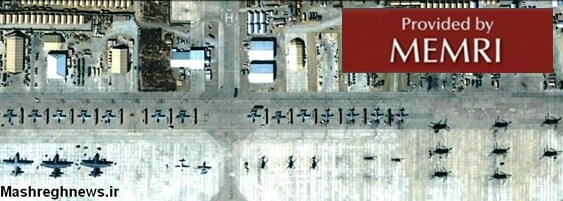
Bagram AFB. The photo clearly shows C-130 transport aircraft and A-10 Warthog tactical attack aircraft
"Other bases and airfields in Afghanistan are Kandahar Airbase, located 387 km from Iran; Shindand Airbase, located 124 km from Iran; and Herat Airbase, located 122 km from the Iranian border. The first of these bases is threatened by Shihab-2 and Qiam missiles, and the two other bases are easily threatened by Zilzal rockets and the highly accurate Fath 110 missiles, as well as by other models.
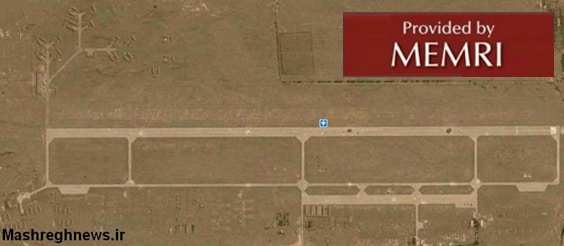
Shindand AFB, where RQ-170 detection drones are stationed
"However, the American super base in the region is Al-Udeid air force base in Qatar. Despite good relations between the two countries [Qatar and Iran], recent stances taken by Qatar vis-à-vis Syria show that the U.S. can still utilize [Qatar to attack Iran].

Al-Udeid AFB in Qatar
"This base, situated in the center of the small nation of Qatar, is located 278 km from the Iranian coast, and has a large number of American aircraft. Spotted at the base were B1-B Stealth Bombers; C-17 and C-130 transport aircraft; KC-135 and KC-10 refueling tankers; [P-3] Orion marine surveillance aircraft; and [E-8] Joint STARS [Surveillance and Target Attack Radar System]. Reports indicate that F-16 fighter jets are also stationed there. This base is within range of the Fath-110 and several other medium- and long-range Iranian missiles. The open air aprons, where dozens of expensive aircraft are parked, are the optimal target for the ballistic missile warheads, and thanks to the wide deployment [of the missiles], most of these aircraft will undoubtedly be destroyed or seriously damaged.
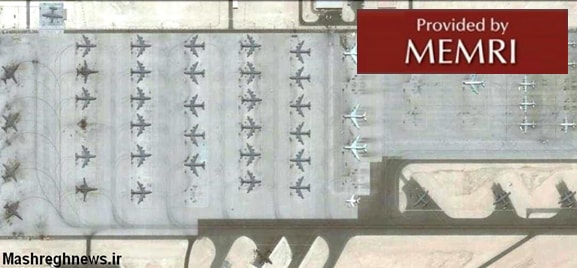
Photo shows KC-135 tankers, P-3 Orion aircraft, and B-1 bombers
"In addition, we should mention the U.S. Fifth Fleet naval base in Bahrain, located only 200 km from Iranian shores. Deployed to the base are several missile boats and warships, including equipment and ordnance. Aside from Zilzal rockets, all [Iranian] short- to long-range missiles can target this location, and considering the nature of the target, using missiles to ensure accurate hits would be more effective.
"The Khalij-e Fars missile – the marine version of Fath-110 missile, with a range of 300 km – is specially designed to hit ships, which makes it highly suitable for threatening this naval base. The Qadr anti-ship cruise missile, which according to [Iranian] Defense Minister [Ahmad Vahidi] has a range of over 200 km, can be launched from several points on the Iranian coast, and [can] hit ships stationed at this base if they move a small distance from it.
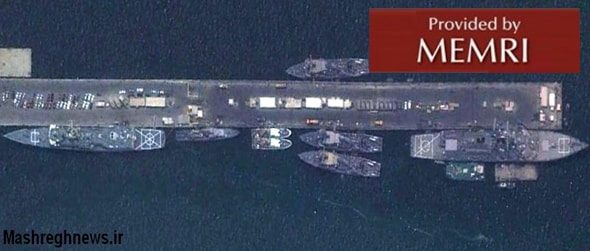
U.S. Fifth Fleet naval base in Bahrain
"Another important American site in Bahrain is the Bahraini Air Force Sheikh Isa Airbase. The base is located 238 km from the Iranian coast and lies within range of all [Iranian] ballistic missiles, as well as the Zilzal-3B rockets. This airbase has two 3,800-meter runways, and spotted there were C-17 [Globemaster III transport aircraft], P-3 Orions, F-16 and F-18 fighter jets, and EA-6B Prowler Electronic Warfare aircraft.
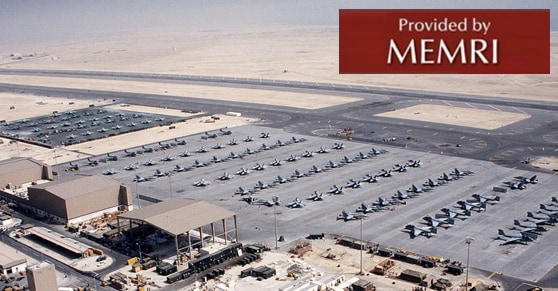
Sheikh Isa AFB with F-18 and Prowler aircraft
"Another large U.S. base in the region is the Al-Dhafra Air Base in the UAE, which has two main runways 4,200 meters in length... and is located 253 km from Iranian shores and 184-255 km from Iranian islands in the Persian Gulf...
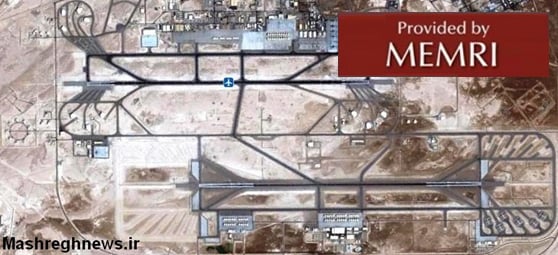
Al-Dhafra AFB, UAE
"This base lies within range of Iran's ballistic missiles. The KC-135 tankers and AWACS [Airborne Warning and Control System] E-3 Sentry aircraft are extremely high value targets for Iranian ordnance.
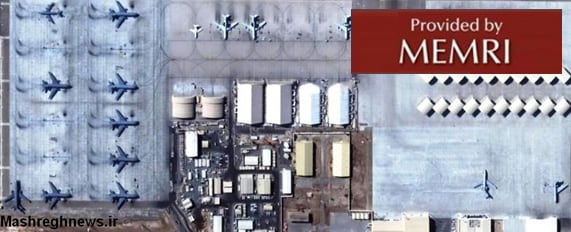
AWACS, refueling tankers, and covered hangers (on the right) at Al-Dhafra Airbase
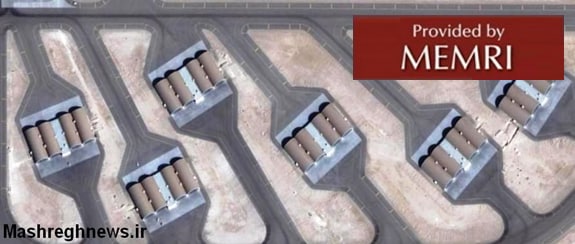
24 fighter jet hangars at the UAE Airbase
"There is widespread American activity taking place at Thumrait air base in Oman. Located 963 km from Iran, it lies within the range of the long-range Shihab-3, Qadr, 'Ashoura, and Sejjil missiles. Another base used by the Americans, albeit mostly for transportation and espionage, is Manas Airbase in Kyrgyzstan, located 1,433 km from Iran. Upgraded Shihab-3 missiles, as well as 'Ashoura, Qadr, and Sejjil missiles, can take care of enemies in the home of our old friend[s].
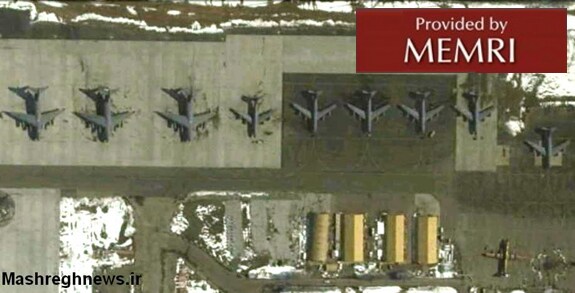
C-17 transport aircraft and KC-135 refueling tankers in Manas
"Incirlik Airbase in Turkey is the pinnacle of U.S. military bases in the region, comparable to Al-Udeid air base [in Qatar]. Although the longstanding presence of U.S. aircraft at this base is a source of shame for Turkey, it seems that the base will also be hosting mercenaries for the arrogant U.S. government, along with long-range bombers and atomic bombs. The base is located 875 km from Iran on the northwestern Syrian border, and the largest aircraft in the U.S.'s arsenal are deployed there. It can be threatened by Iran's long-range missiles.
"The Americans also use bases in Pakistan, including the important Shamsi Airbase, located 199 km from Iran, and Shahbaz Airbase, located 527 km [from Iran]. According to information in the professional military media, [the U.S.] uses Shamsi Airbase for drone aircraft. Despite the current good relations between the Pakistani government and Iran, in light of the political instability there over the past two decades Iran could be threatened from that area as well. Shamsi Airbase can be threatened by Zilzal B3 rockets, as well as all Iranian ballistic missiles. Shahbaz Airbase can be hit by medium- and long-range ballistic missiles...
"After Iraq conquered Kuwait, many bases in Saudi Arabia were transferred to the Americans but were later evacuated. Now there is only a limited presence of U.S. air units at Prince Sultan Airbase, located 575 km from Iran, which can be hit by Iranian medium- and long-range missiles.
"Although U.S. aerial defense systems have been deployed in several countries in the region, launching accurate long-range missiles from deep inside Iranian territory as a first strike, with the missile velocity at mach 10-12, makes the enemy's attempts to destroy them impossible. In addition, some of these aerial defense systems could be part of the initial target in Iran's missile response.
"Moreover, simultaneous launches of a large number of missiles and rockets from different locations are another way to overcome these [defense] systems. Additionally, Iran possesses long-range air-to-surface missile systems, and anti-Radar missiles to suppress enemy aerial defense... and facilitate the work of Iran's ballistic missiles."
[1] Reuters.com, November 21, 2011
[2] Sharq (Iran), December 15, 2011; ISNA (Iran), December 14, 2011. An article on the Mardomak website, which is operated from outside Iran, stated that the closing of the strait was an empty threat: "As long as Iran's economy is dependent upon oil, and the export of crude oil passes through the Persian Gulf, the closing of the Strait of Hormuz will remain [nothing but] a verbal threat... Even if the tension between Iran and the U.S. increases considerably, the closing of the strait will not be an option. Iran will respond to the pressure by other means." Mardomak.org, December 22, 2011.
[3] Fars (Iran), December 13, 2011. The oil minister denied reports that Iran plans to close the strait as part of the exercise. Mashreq News (Iran), December 16, 2011.
[4] Kayhan (Iran), December 13, 2011. In addition, a group of Majlis members circulated a petition defending Iran's right to close the strait in response to oil sanctions. Kayhan (Iran), December 19, 2011.
[5] Yjc.ir, December 22, 2011.
[6] See MEMRI Inquiry and Analysis No. 615, Iran Demonstrates Its Deterrent Strength in Military Maneuvers, June 14, 2010; MEMRI Special Dispatch No. 2029, Iran Threatens to Close Strait of Hormuz If Attacked, August 19, 2008; MEMRI Inquiry and Analysis No. 407, Iran's Response to Western Warnings: 'First Strike,' 'Preemptive Attack,' Long-Range Ballistic Missiles, 'Asymmetric [Guerilla] Warfare,' November 28, 2007.
[7] Mashreq News (Iran), December 15, 2011.
[8] Al-'Aalam TV (Iran), January 24, 2012. See MEMRI TV Clip No. 3284, Iranian MP Hossein Ebrahimi, Deputy Chairman of Iranian Majlis National Security Committee: "The Persian Gulf Will Be Turned into a Graveyard" for International Forces, January 24, 2012. Ali Akbar Velayati, advisor to Iranian Supreme Leader Ali Khamenei, stressed that Tehran would not permit a situation in which it could not sell oil while other oil producers could do so. Press TV, Iran, January 26, 2011. Hossein Shariatmadari, editor of Kayhan and an associate of Khamenei, called for inspections for vessels in the Strait of Hormuz and for the subsequent closure of the strait to all E.U. vessels. He said that the West would be harmed more by the boycott than Iran would. Kayhan, Iran, January 25, 2012. Kayhan itself mocked U.S. President Barack Obama's statement that all options against Iran were on the table, calling it a "bluff" because the American threats were aimed at persuading Tehran to agree to negotiations. It added that the Americans had no option other than begging for negotiations with Iran. Kayhan, Iran, January 29, 2012.
[9] Fars (Iran), January 23, 2012. It should be noted that Iranian Foreign Ministry spokesman Ramin Mehmanparast, as well as Iranian Navy deputy commander Mahmoud Moussavi, clarified in December 2011 that Iran has no intention of closing the strait. This, apparently out of awareness that any military aggression of this sort would be tantamount to a declaration of international war, and also due to the clear U.S. military supremacy in the Gulf. Iran (Iran), December 14, 2011 (Mehmenparast) and Press TV, Iran, January 2, 2012 (Moussavi).
[10] Al-Hoda added that President Obama's emphasis in his letter to Khamenei that the U.S. would not attack Iran reflects Tehran's might versus Washington's weakness. ISNA, Iran, January 27, 2012.
[11] Fars (Iran), January 15, 2011; Iranian TV interview on November 27, 2011, Lenziran.com, November 27, 2011.
[12] Khorasan (Iran), January 19, 2012.
[13]Serat News (Iran), December 12, 2011.
[14] Mashregh News (Iran), December 14, 2011.



